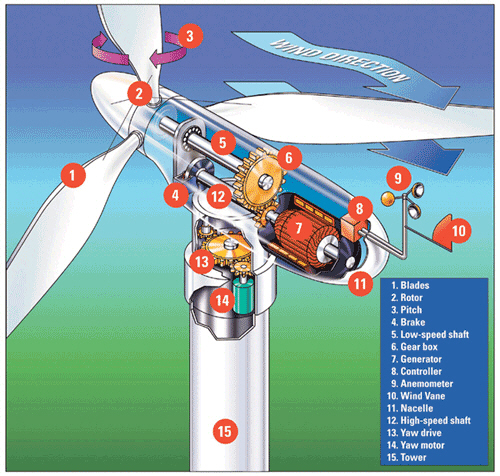___________________________________________________________________
A typical small wind generator has rotor that is directly coupled to the
generator which produces electricity either at 120/240 volt alternating current
for direct domestic use or at 12/24 volt direct current for battery charging.
Larger machines generate 3 phase electricity. There is often a tail vane which
keeps the rotor orientated into the wind. Some wind-machines have a tail vane
which is designed for automatic furling (turning the machine out of the wind) at
high wind speeds to prevent damage. Larger machines have pitch controlled blades
(the angle at which the blades meet the wind is controlled) which achieve the
same function. The tower is of low solidity to prevent wind interference and are
often guyed to give support to the tower.

Figure 2: The Practical Action small wind turbine.
Grid connected or battery charging
Depending on the circumstances, the distribution of electricity from a wind
machine can be carried out in one of various ways. Commonly, larger machines are
connected to a grid distribution network. This can be the main national network,
in which case electricity can be sold to the electricity utility (providing an
agreement can be made between the producer and the grid) when an excess is
produced and purchased when the wind is low.
Using the national grid helps provide flexibility to the system and does away
with the need for a back-up system when windspeeds are low. Micro-grids
distribute electricity to smaller areas, typically a village or town. When wind
is used for supplying electricity to such a grid, a diesel generator set is
often used as a backup for the periods when windspeeds are low. Alternatively,
electricity storage can be used but this is an expensive option. Hybrid systems
use a combination of two or more energy sources to provide electricity in all
weather conditions. The capital cost for such a system is high but subsequent
running costs will be low compared with a pure diesel system.
In areas where households are widely dispersed or where grid costs are
prohibitively expensive, battery charging is an option. For people in rural
areas a few tens of watts of power are sufficient for providing lighting and a
source of power for a radio or television. Batteries can be returned to the
charging station occasionally for recharging. This reduces the inconvenience of
an intermittent supply due to fluctuating windspeeds. 12 and 24 volt direct
current wind generators are commercially available which are suitable for
battery charging applications. Smaller turbines (50 -150 watt) are available for
individual household connection.